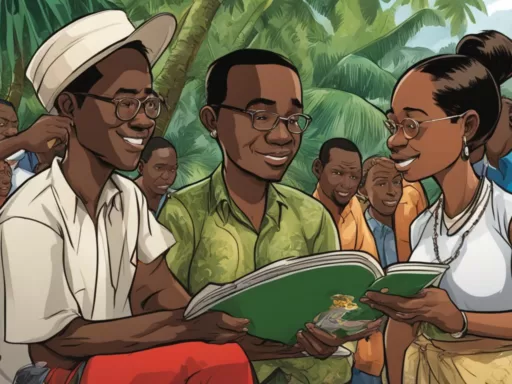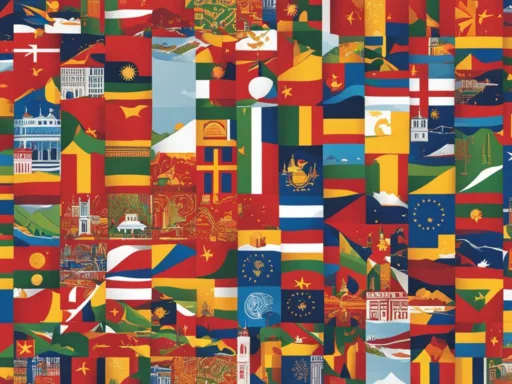When one thinks of Malawi, it may come as a surprise to learn that this small landlocked country is a melting pot of linguistic diversity. While many nations pride themselves on a single unifying language, Malawi breaks the mold with over 16 languages vividly coloring its cultural canvas. Surprising yet true, the number of **languages spoken in Malawi** tackles the perception that small countries have homogeneous linguistic identities. From the **Malawi official languages** with English’s administrative precision to Chichewa’s cultural embrace, the array of tongues in this southeastern African nation provides a unique lens through which we can appreciate the depths of **Malawi’s language diversity**.
Key Takeaways
- The rich tapestry of Malawi is threaded with more than just a few dialects but boasts over 16 languages.
- English serves as an official language, facilitating international dialogue and reinforcing Malawi’s global connections.
- Chichewa, the heart of Malawi’s national identity, is spoken by the majority, holding the title of the national language.
- An exploration of Malawi’s languages uncovers a spectrum of linguistic expressions from Chinyanja to Chitumbuka.
- Understanding Malawi’s linguistic fabric is key to appreciating its complex cultural and ethnic kaleidoscope.
- Multilingualism in Malawi is not just prevalent but immensely influential in its socio-cultural dynamics.
An Overview of Malawi’s Linguistic Landscape
The Republic of Malawi, a landlocked country in southeastern Africa, is renowned for its linguistic diversity, which mirrors its cultural richness. With numerous indigenous languages forming the bedrock of Malawian identity, an exploration into the nation’s language demographics provides a window into its soul. The primary languages, including Chichewa and English, are only the beginning of the story. Malawi’s multiculturalism is further accentuated by the prevalence of several local dialects and ethnolinguistic groups, each with their distinct linguistic contributions.
A Glimpse into Malawi’s Diverse Language Demographics
Delving into the demographics of languages unveils a tapestry of indigenous languages in Malawi that are as varied as they are vital. The Malawian Lomwe, primarily spoken in the southeastern parts of the country, and the Sena dialect in the south, showcase the regional linguistic diversity. Further north, the tones of Kokola and Lambya add to the ethnic variety, creating a milieu where language serves as a unique identifier for its people.
Recognizing Malawi as a Multilingual Nation
Recognizing and appreciating Malawi as a multilingual nation involves understanding the significance of its language spectrum. Beyond the most spoken languages in Malawi like Chichewa and English, reside the voices of numerous smaller communities, each echoing the narrative of their traditions through their vernacular. It is the coexistence of these tongues—from the Tonga in the north to the Nyakyusa-Ngonde in the southern belt of the Nyika Plateau—that cements Malawi’s reputation as a vibrant and multilingual society.
The Prominence of Chichewa in Malawi
As the beating heart of Malawi’s linguistic heritage, Chichewa serves not only as the cornerstone of communication but also as a vibrant emblem of national identity. Vital to both social and official discourse, the roots of the Chichewa language run deep, weaving a narrative that mirrors the nation’s spirit and its people’s shared experiences.
Chichewa: The National Language of Malawi
Chichewa, or Nyanja as it is sometimes known, holds the esteemed title of national language in Malawi, effortlessly bridging diverse ethnic groups across the country. With its melodic tones and rich vocabulary, Chichewa resonates with over half of Malawi’s population, reinforcing social unity and facilitating mutual understanding.
Government Efforts to Promote Chichewa
The Malawian government, cognizant of the significance of Chichewa as one of the Malawi official languages, has fortified its status through legislation and educational initiatives. Aiming to preserve and enrich this linguistic treasure, policies are dynamically designed to embed the national languages of Malawi into the very fabric of the nation’s growth.
Cultural Identity and Chichewa
The Chichewa language is far more than a medium of communication—it is an intrinsic element of cultural identity, symbolizing the rich traditions, storied history, and dynamic present of Malawi. It is through Chichewa that the Malawian people express their values, articulate their creativity, and celebrate their heritage.

| Region | Demographics | Use in Media | Educational Implementation |
|---|---|---|---|
| Central Malawi | Widespread use among the populace | Main language for broadcasts and publications | Primary medium of instruction in early education |
| Southern Malawi | Prevailing lingua franca | Integral in community and local radio | Used for cultural and historical teachings |
| Northern Malawi | Secondary to regional tongues | Adapted for regional inclusivity | Supporting language in diverse classrooms |
In summary, the Chichewa language stands as a beacon of pride and unity in Malawi, an enduring testament to the nation’s commitment to cherish and uphold its linguistic legacy for generations to come.
English: Malawi’s Official Language
When traversing the intricate mosaic of Malawi language diversity, one cannot overlook the significance of the English language in Malawi. Since its introduction by British colonialists in the late 19th century, English has not only retained its status but has become an integral part of the nation’s official and educational spheres. Despite the end of colonial rule, English’s adoption as one of the Malawi official languages represents its deep-seated influence and ongoing relevance in administrative, educational, and international affairs.

The presence of English is indeed pervasive. It facilitates international diplomacy, trade, and higher education—a bridge connecting Malawi to the global stage. In government schools, it stands as a compulsory second language, underscoring its utility for opening doors to global opportunities for Malawi’s youth. Furthermore, in international schools within Malawi, English is the medium of instruction, preparing students to be global citizens.
- Formal Administration: Legal documents, legislative proceedings, and executive communications.
- Education: A core subject in schools and the primary language in tertiary education.
- International Relations: Diplomatic communication and international agreements.
The ubiquity of the English language in Malawi is further witnessed in media and business, asserting its position as an indispensable asset in the country’s diverse linguistic landscape.
| Language | Utilization | Percentage of English Speakers |
|---|---|---|
| English | Official, Education, Business, Media | Not the majority but widely understood and spoken |
| Chichewa | National, Daily Communication | Over 57% |
| Other Indigenous Languages | Cultural and Regional Use | Various |
This corner of linguistic richness where English coexists with Chichewa and other indigenous tongues paints a vivid image of Malawi’s language diversity, a testament to its cultural wealth and adaptability.
Multilingualism in Malawi’s Regions
The vibrant country of Malawi is a cornucopia of cultures, each accompanied by a unique linguistic identity. Beyond the ubiquitous Chichewa and English, the nation’s language diversity is a testament to its rich cultural fabric. A collage of languages and Malawi local dialects weave together the regional languages of Malawi, underscoring the multilingual nature of its society.
Regional Languages and Where They Are Spoken
In the exploration of Malawi’s languages, one can traverse from the northern tips to the southern bounds, uncovering a variety of dialects and regional tongues. The Yao language resonates through the southern landscapes, while the lilt of Tumbuka fills the air in the northern regions. Each language zone echoes the diversity and cultural essence of its populace.
The Linguistic Fabric of Malawi’s Diverse Communities
Malawi’s linguistic diversity is etched into the everyday lives of its communities. The regional languages Malawi boasts are more than just communication tools; they serve as cultural beacons. This spectrum of dialects and languages offer us a glimpse into the intricate tapestry of Malawi’s heritage – a heritage enlivened through multifaceted expressions of language.

| Region | Dominant Language | Speakers (Estimated) |
|---|---|---|
| Central | Chichewa | Over 7 million |
| South | Yao | Approximately 2 million |
| North | Tumbuka | Around 1.5 million |
| North-East | Lomwe | Nearly 250,000 |
| North-West | Tonga | Close to 170,000 |
| East | Nyakyusa-Ngonde | Over 300,000 |
| South-East | Malawian Sena | Significant population |
The Rich Tapestry of languages spoken Malawi
Malawi’s cultural and historical narrative is intricately intertwined with its Malawian linguistic diversity. The nation’s rich palette of dialects is a testament to its complex societal fabric, with over 16 individual languages that furnish the everyday life of its people. Below, we unravel the multitude of languages that contribute to language diversity in Malawi, spotlighting the lesser-known yet equally significant tongues that color the Malawian linguistic landscape.
Unpacking the Layers of Malawi’s Language Diversity
To truly appreciate the most spoken languages in Malawi, one must look beyond Chichewa and English to uncover the broad array of dialects that are spoken across the country. These languages not only function as a means of communication but also as vessels of cultural expression and identity among the diverse communities within Malawi. Each language carries its unique set of sounds, proverbs, and storytelling traditions, which enrich the national cultural tapestry.
Exploring Malawi’s Lesser-Known Languages
It is within the shadows of the more prominent Malawian languages that we find linguistic gems such as Lambya, Kokola, and Ndali. These languages, although spoken by smaller groups, display the resilience and adaptability of Malawi’s ethnolinguistic minorities. They are etched into the memories of their speakers, safeguarding traditions and wisdom across generations. The survival and active usage of these languages are crucial for the continuity of the diverse linguistic ecology of Malawi.
In conclusion, exploring Malawi’s linguistic landscape is akin to traversing a labyrinth of cultural influences and historical convergences. From the bustling marketplaces where Chichewa is intermingled with English to the rural heartlands where indigenous languages hold sway, the country’s language diversity is a rich, complex narrative, waiting to be explored, appreciated, and certainly, celebrated.
Malawi’s Indigenous Languages and Their Speakers
Exploring the indigenous languages of Malawi reveals a vibrant element of the nation’s cultural identity. These languages, intertwined with the country’s history and traditions, are an indispensable part of Malawi’s heritage. Varying in presence from the shores of Lake Malawi to the heights of the Zomba Plateau, local dialects offer an insight into the nation’s rich ethnic diversity.
Indigenous Languages: A Vital Part of Malawi’s Heritage
The vast tapestry of Malawi’s linguistic heritage is adorned with languages like Yao and Tumbuka, which echo through the local communities and marketplaces. Not just a means of communication, these languages encapsulate folktales, wisdom, and social customs passed down through generations. Within their cadences lie the heartbeat of Malawi’s cultural legacy.
Demographics of Malawi’s Indigenous Language Speakers
Delving into the demographics of language speakers in Malawi unveils a portrait of diversity. Emerging from data, we can spot regional centers where languages such as the Malawian Lomwe and Nyakyusa-Ngonde are most prevalent. These languages, while not as widely spoken as Chichewa or English, are critical threads in the overall fabric of Malawi local dialects. Below are approximate numbers of speakers for selected indigenous languages:
| Language | Speakers |
|---|---|
| Malawian Lomwe | Approx. 250,000 |
| Nyakyusa-Ngonde | Approx. 300,000 |
| Lambya | Tens of Thousands |
| Ndali | Lesser Known |
Even languages with fewer speakers carry strong significance. The dialects of the smaller ethnic groups such as Ndali or Lambya serve not just as communication tools, but as living artifacts of Malawi’s unique human treasure. It remains a collective responsibility to support and preserve these voices as part of indigenous languages Malawi, enriching the nation’s—and the world’s—cultural diversity.
Malawi’s Use of Language in Education and Media
The interplay between language and education forms a cornerstone of Malawi’s societal development. Malawi language education showcases an inclusive landscape where native and international languages enrich the learning environment. English is not only a subject in the curriculum but a language of instruction from the fourth grade onwards, vital for global communications and opportunities. However, it is Chichewa that lies at the heart of primary education, employed as the initial medium of instruction to bridge understanding and inclusivity.
Turning to the realm of Malawian media languages, the linguistic diversity extends to television, radio broadcasts, and print media. While English dominates national publications and some broadcast channels, providing an avenue for international discourse, Chichewa serves as the voice of the people, reflecting local narratives and ensuring widespread accessibility.
Malawian linguistic diversity is more than a mosaic of languages; it’s vital for unity and education. There exists a harmonious balance in the dissemination of knowledge and news, with multiple languages fostering a collective national identity while also offering a window to the world.
| Education Sector | Primary Language Used | Objective |
|---|---|---|
| Primary Schools | Chichewa | Facilitate foundational understanding and inclusivity |
| Secondary and Higher Education | English | Prepare students for global participation and advanced academics |
| Adult Education | Bilingual Approach | Enhance literacy and socioeconomic growth |
In summary, the dual-language approach in Malawian education and media underscores an ambidextrous society. Whether for local engagement or global interaction, language serves as a unifier and an empowerer across the vibrant landscapes of Malawi.
Local Dialects and Linguistic Variations Within Malawi
Stepping into Malawi is like entering a gallery where each painting reflects a unique dialectical palette. The local dialects of Malawi are not mere linguistic expressions but are the threads that weave the nation’s cultural fabric. The linguistic diversity in Malawi echoes through the bustling markets, meandering rivers, and rolling hills of the warm heart of Africa. With the vivid hues of Malawian linguistic variations, one can listen to a spectrum of dialects that make every conversation a testament to the region’s rich heritage.
The Intricacies of Malawi’s Local Dialects
Each community in Malawi boasts its own dialectal charms. Within the Chichewa-speaking majority, the intonations and vocabulary vary from one district to another. This linguistic richness extends to the Yao, Tumbuka, and other languages, where native speakers exhibit a pride in the nuances of their speech. These local dialects are a living library of Malawi’s ancestral lineage, carrying stories and traditions through their distinct sounds and structures.
Understanding Linguistic Variations Across Communities
Appreciating the linguistic diversity in Malawi requires more than a cursory knowledge of its main languages. It necessitates a deep dive into the variations that distinguish the Malawian linguistic landscape. From the food they eat to the songs they sing, the language of each region wraps around its daily life, giving insight into the local ethos. To truly grasp the heart of Malawi, one must attune to the subtleties that these variations present, bringing into focus the enriching complexity of this nation’s verbal expression.
Local Dialects and Linguistic Variations Within Malawi
What are the main languages spoken in Malawi?
The main languages spoken in Malawi include English, which is the official language, and Chichewa, which is the national language and the most widely spoken. Other significant languages include Chinyanja, Chiyao, and Chitumbuka, as well as a variety of indigenous languages such as Malawian Lomwe, Kokola, Lambya, Nyakyusa-Ngonde, Malawian Sena, and Tonga.
How does Malawi’s linguistic diversity reflect its culture?
Malawi’s linguistic diversity is a reflection of its multicultural society. With several indigenous languages and dialects spoken across the country, each community contributes to the rich cultural tapestry that characterizes Malawi. The presence of these languages highlights the nation’s historical, ethnic, and cultural pluralism.
Why is Chichewa considered the national language of Malawi?
Chichewa is considered the national language of Malawi because it is spoken by the majority of the population and serves as a unifying cultural symbol. It is also the most used local language in media and education, thus holding a significant place in Malawian society.
What efforts are being made to promote Chichewa in Malawi?
The government of Malawi actively promotes Chichewa through its inclusion in the education system as a medium of instruction, widespread use in broadcast media, and the coordination of research and development activities regarding the language, which is undertaken by institutions such as the Center for Language Studies.
How did English become the official language of Malawi?
English became the official language of Malawi during the late 19th century under British colonisation. Following independence, English continued to play a crucial role in the nation’s governance, education system, and international communications, reinforcing its status as an indispensable administrative and communication tool.
Which languages are specific to certain regions of Malawi?
Regional languages in Malawi often correspond to specific areas: Yao is predominantly spoken in the Southern Region, Tumbuka is widely spoken in the Northern Region, while indigenous languages like Lomwe, Nyakyusa-Ngonde, Malawian Sena, and Tonga are spoken in various localized communities within these regions.
How does regional language spread influence Malawi’s community interactions?
The spread of regional languages in Malawi fosters a sense of community and maintains cultural traditions within specific locales. It also influences daily communication and interactions, with each language bringing unique cultural perspectives and practices to the fore, further enriching Malawi’s societal fabric.
What is the extent of language diversity within Malawi?
Language diversity within Malawi extends to more than 16 living languages. This diversity includes minor languages such as Lambya, Kokola, and Ndali, each contributing to the intricate linguistic quilt that makes up the country’s rich and varied linguistic landscape.
Are there lesser-known languages in Malawi?
Yes, Malawi is home to several lesser-known indigenous languages, including Nyiha, Nyika, and others that may have smaller numbers of speakers but are still integral to the country’s linguistic and cultural diversity.
How important are indigenous languages to Malawi’s heritage?
Indigenous languages are a vital part of Malawi’s heritage as they carry the histories, traditions, and cultural practices of their respective ethnic groups. They are key to understanding the nation’s diverse cultural landscape and maintaining the cultural identity of various Malawian communities.
What are the demographics of indigenous language speakers in Malawi?
Indigenous language speakers in Malawi make up a significant portion of the population, with languages like Malawian Lomwe and Nyakyusa-Ngonde each having hundreds of thousands of speakers. Even languages with fewer speakers have dedicated communities that preserve and continue their linguistic traditions.
What role do languages play in Malawi’s educational system?
In Malawi’s educational system, languages play a central role in facilitating learning and communication. Chichewa is used as a medium of instruction in primary schools, and English is mandated as the language of instruction from secondary schools and beyond. This approach aims to ensure that students are proficient in both the national and official languages.
How are languages represented in Malawi’s media?
Languages in Malawi’s media are well-represented with a focus on both national and official languages. Chichewa is widely used in radio and television broadcasts catering to a broad audience, while English is commonly used for international news and communications. This representation in media aids in language preservation and accessibility for all Malawians.
Do local dialects in Malawi differ significantly from one another?
Yes, local dialects in Malawi can differ noticeably, with distinct variations apparent within the Chichewa-speaking communities and among other languages. These dialects reflect the diverse influences and histories of the various regions of Malawi.
Why is it important to understand linguistic variations across Malawian communities?
Understanding linguistic variations is important for appreciating the complexity and nuance of communication within Malawian communities. It helps in recognizing the unique cultural identities embodied within each dialect and fosters a deeper connection and respect among different ethnic groups in Malawi.






